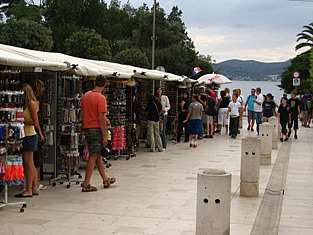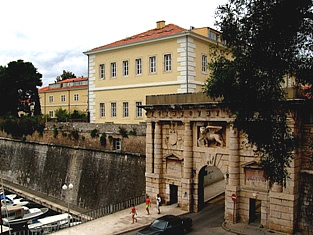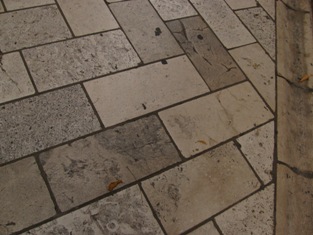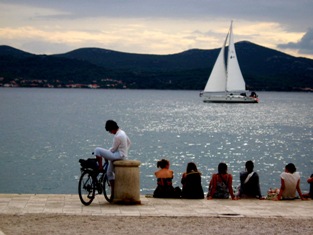
Mediaeval Zadar gates
.. The new town Quay of Zadar is most beautiful town quay worldwide. This superlative statement is definitely well-founded as there are only few such nice and pleasant coastal promenades in the world. The south-western side of the city, overlooking the sea, was enclosed by fortifications for centuries. Hardly anything is known about the forms and technology of rotifications in the classical atiquity in this part of the city. In mediaeval times, a straight rampart extended along the entier prospects with several rectangular protrosions in the form of open towers. The rampart had only two gates: Porta Angeli (Angel's Gate), reinforced with two flanking rectangular towers, and the small gate known as Pusterla. With the construction of new, Renaissance ramparts in the second half of the 16th century, this section was slightly changed. The mediaeval ramparts have mostly been preserved, except for having been lowered and filled up from inside, and reinforced with the construction of St. Francis's Bastion and St. Mary's Bastion, named after the nearby monastery chuches. In front of the Angel's Gate, a slaughterhouse was built, so that in 1580 a new gate was built, known as Porta Baccaria in front of Campa, the square in front of the Archibishop's Palace. The new town Quay of Zadar In 1868
The new town Quay of Zadar In 1868
..In 1868 Zadar was proclaimed an open city and the fortifications lost their original purpose. As the capital of the Austrian province of Dalmatia, Zadar was renovated and rehabilitated in accordance with architectural and horticultural principles of that period. In the centre of the city, a huge courthouse was built in the Neo-Tuscan style. In the eastern and northern bastions, municipal landscape parks were arranged, and the southern ramparts were completely pulled down in the period 1871-1874. Instead of them, the new town quay was built, a fashionable promenade with eighteen residential and public palaces. A large stone embankment (pier) was built, as a place for anchoring of fast coastal steamships, such as the famous Baron Gautsch. Despite immeasurable loss due to dismantling of the ramparts, the New Town Quay has changed the panorama of the city and become its new asset. The public life of Zadar was thus relocated from the squares and streets to the quay, with a number of fashionable hotels, restaurants, coffe houses, public and cultural institutions (e.g. Croatin Reading-room), but also because of the attractiveness of huge steamships coming into dock, first-class social events, picturesque island boats, bragozzi (Dalmatian smacks), two-mast costers and sailing boats.
 The face of Zadar town
The face of Zadar town
.. On the inner northern side of the afore mentioned palaces, a new longitudinal street was formed – Viale Tomaseo (today the Street of the Treaty of Zadar 1358 and Mihovil Pavlinovič Street), and close to the embankment a picturesque market place, the so-called Green Square (Piazza delle Erbe).
The New Town Quay was one of the most demolished parts of the city during the Second World War (1943-1944). All buildings except for the Bristol Hotel (today Zagreb), the Borelli Palce and St. Demetrius's Girls High School (today the Faculty of Philosophy) were devastated.
 The embankment was also heavily bombed and lost many of its original features together with the entire coast. The post-war reconstruction and rehabilitation did not include construction of new buildings on that location, except for a clumsy stone residential house on the western end.
The embankment was also heavily bombed and lost many of its original features together with the entire coast. The post-war reconstruction and rehabilitation did not include construction of new buildings on that location, except for a clumsy stone residential house on the western end.
The »face of the city« was formed by a row of new buildings along the northern side of the Street of the Treaty of Zadar, which proved inadequate in terms of location and form.
The green belts, planned for future construction, have thus become valuable parks and added much to the values of the New Town Quay, so dear to the citizens of Zadar.
